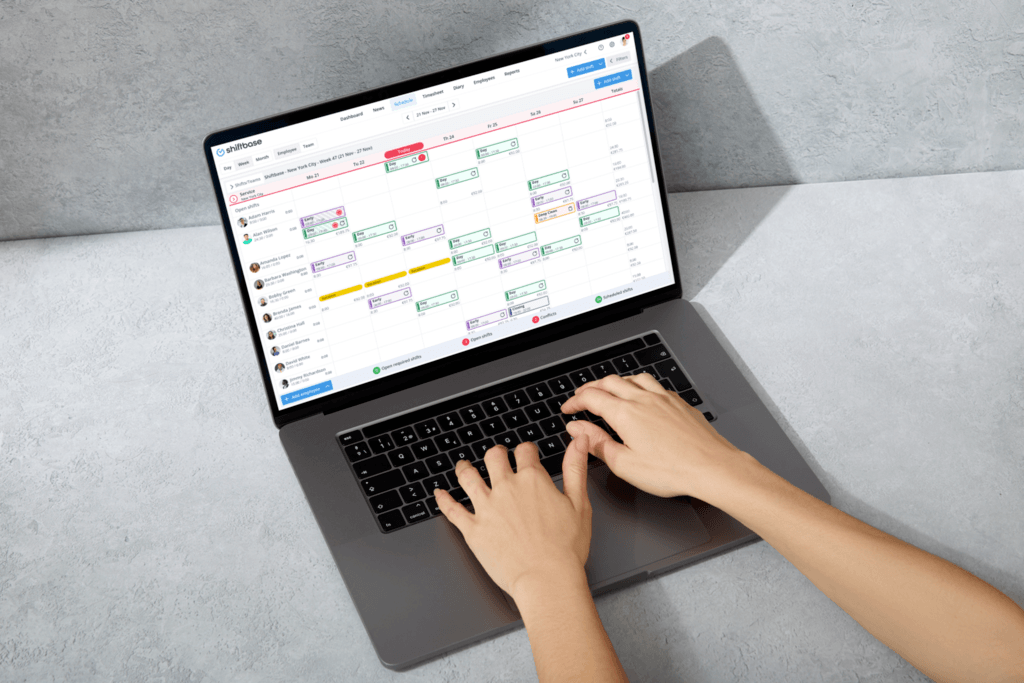Handling employee schedules for multiple locations can be a tricky balancing act that many managers and employers of multi-location businesses face daily. Between managing employee availability, avoiding scheduling conflicts, and ensuring efficient scheduling across the board, it’s no wonder you’re looking for the best practices to streamline the scheduling process.
Whether you’re running a small or medium business or managing multiple employees at a big enterprise, mastering multi-location employee scheduling is crucial. With the right employee scheduling software and a few clever strategies, you can turn this daunting task into a well-oiled machine.
This blog will explore practical tips and tricks to help you manage employee schedules, reduce labor costs, and keep your team happy and engaged.
So, grab a coffee, get comfortable, and let's dive into the best practices for multi-location employee scheduling.
Key challenges in multi-location employee scheduling
Managing employee schedules across multiple locations is no small feat. Let’s dive into the main hurdles you might face and how to tackle them.
Balancing staffing levels
One of the trickiest parts of multi-location employee scheduling is balancing staffing levels. Understaffing can lead to overworked employees and poor customer service, while overstaffing increases labor costs unnecessarily.
It’s crucial to find that sweet spot where each site has just the right number of staff to meet its unique demands.
Tracking availability and preferences
Keeping track of employee availability and preferences across multiple locations can be like herding cats. Accurate records of employee availability and preferences are essential to prevent scheduling conflicts.
With multiple employees having different shift preferences and availability, maintaining an up-to-date schedule can feel like a full-time job in itself. Using employee scheduling software can help manage this data efficiently and reduce scheduling conflicts.
Communication and coordination
Clear communication between central management and site-specific managers is key to successful multi-location scheduling. Without consistent communication tools, coordinating shift assignments and managing work schedules can become a nightmare.
Effective communication ensures everyone is on the same page, minimising misunderstandings and ensuring smooth operations. Implementing a consistent communication tool can greatly aid in this process.
By addressing these key challenges, you can streamline your scheduling process, improve employee satisfaction, and ensure your business operations run smoothly across all locations.
Essential strategies for effective scheduling
Mastering multi-location employee scheduling requires some smart strategies. Here are a few essential ones to get you started.
Centralising scheduling processes
Using a unified scheduling platform is a game-changer for multi-location businesses. Centralising your scheduling processes helps streamline coordination and data management. By using employee scheduling software, you can manage employee schedules, shift assignments, and track employee hours across multiple locations from one central system. This not only saves time but also reduces the likelihood of scheduling conflicts and errors.
Implementing geofencing and time tracking
Geofencing and time tracking are essential features for effective scheduling. Geofencing allows you to set virtual boundaries around your work sites, ensuring employees are clocking in and out at the correct locations. This can help accurately log employee attendance and manage shifts more effectively. Pairing this with a reliable time clock system, you can easily track employee hours and reduce the chances of buddy punching or time theft.
Using automation tools
Automation tools can significantly reduce the administrative burdens of scheduling. Automated scheduling features, like auto scheduling, can create schedules based on employee availability, preferences, and business needs. These tools use historical data and advanced features to predict staffing needs and create efficient schedules. By automating schedule creation and adjustments, you can focus more on managing business operations and less on juggling multiple schedules manually.
Implementing these strategies can make managing work schedules across multiple locations much smoother, leading to better employee satisfaction and more efficient scheduling processes.
Enhancing employee satisfaction and engagement
Happy employees lead to a thriving business. Let’s look at how you can keep your team engaged and satisfied with their schedules.
Considering employee preferences
Accommodating employee scheduling preferences is a key factor in boosting morale and employee satisfaction. When you consider an employee's availability and preferred shifts, you show that you value their work-life balance. Using scheduling software that allows employees to input their preferences and swap shifts can make it easier to create schedules that work for everyone. This flexibility helps in reducing turnover and keeping your staff motivated.
Transparent and fair scheduling practices
Maintaining transparency and fairness in your scheduling processes is essential to build trust among your team. When employees understand how scheduling decisions are made, they are more likely to feel treated fairly. Using employee scheduling software to create and manage schedules ensures that everyone has equal access to shift assignments and that there is no favoritism. Clear and consistent communication about scheduling policies and criteria can also help in managing expectations and maintaining fairness.
Providing timely updates and changes
Providing timely updates and changes to work schedules is crucial to minimise confusion and ensure smooth operations. Using a consistent communication tool, like mobile apps integrated with your scheduling software, allows you to quickly inform employees of any changes. Automated notifications about schedule updates, shift swaps, and available shifts can keep everyone in the loop and reduce last-minute chaos. This approach not only keeps your team informed but also enhances overall operational efficiency.
By focusing on these strategies, you can improve employee satisfaction, reduce scheduling conflicts, and create a more engaged and productive workforce across multiple locations.
Ensuring compliance and consistency
Staying compliant and maintaining consistency across multiple locations is key to smooth operations and happy employees.
Adhering to labor laws and regulations
Navigating the maze of local labor laws and regulations is crucial for any multi-location business. Each location may have different labor laws regarding employee hours, breaks, and overtime. Failing to comply can lead to hefty fines and unhappy employees. By using employee scheduling software with built-in compliance checks, you can ensure that your schedules adhere to all relevant labor laws. This helps in managing work schedules without the risk of legal issues, keeping your business operations smooth and trouble-free.
Maintaining consistent service quality
Consistent staffing is vital for delivering uniform customer service across all locations. Customers expect the same level of service whether they visit one location or another. By using a centralized scheduling process and ensuring that employee schedules are balanced, you can maintain consistent staffing levels. This consistency helps in delivering reliable service quality and building a trustworthy brand. Using historical data to predict staffing needs and implementing time tracking tools can further ensure that each location is adequately staffed at all times.
Focusing on compliance and consistency not only protects your business but also enhances the overall customer experience, making your multi-location business a well-oiled machine.
Leveraging technology for improved scheduling

Harnessing the power of technology can transform your scheduling process, making it more efficient and less stressful.
Choosing the right employee scheduling software
Selecting the right employee scheduling software is crucial for managing multiple locations effectively. Look for scheduling software with mobile apps, so managers and employees can access schedules anytime, anywhere. Integration capabilities with other business systems, like payroll and time clock tools, are also important to streamline operations and reduce administrative burdens. Advanced features such as auto scheduling, shift swapping, and attendance tracking can significantly enhance your scheduling process.
Training managers and staff
Once you have the right scheduling software, training managers and staff is essential. Effective training ensures everyone can utilise the scheduling tools and systems to their full potential. This training should cover how to create schedules, manage employee availability, and use mobile apps for real-time updates. Providing continuous training and support helps in keeping everyone on the same page and reduces the likelihood of scheduling conflicts. Well-trained staff can better manage employee schedules, improving overall efficiency and employee satisfaction.
By leveraging technology and ensuring proper training, you can create a more efficient scheduling process that benefits both your business and your employees.


Simplify multiple locations scheduling with Shiftbase
Managing work schedules across multiple locations can be a challenge, but Shiftbase makes it easy. With employee scheduling, time tracking, and absence management features, Shiftbase is the perfect solution for multi-location businesses. Our software helps you create efficient schedules, track employee hours, and manage absences seamlessly. Ready to streamline your scheduling process and improve employee satisfaction? Try Shiftbase for free for 14 days and see the difference it can make in managing your workforce.


